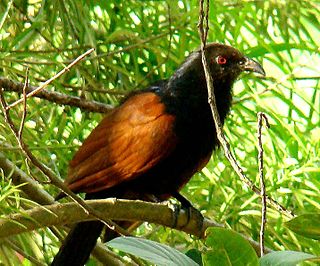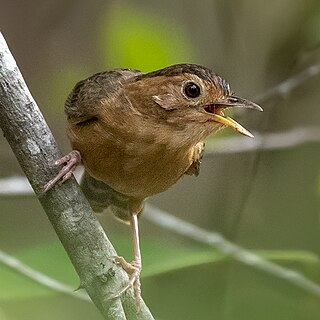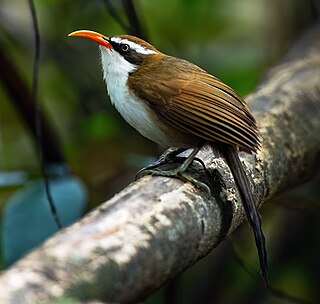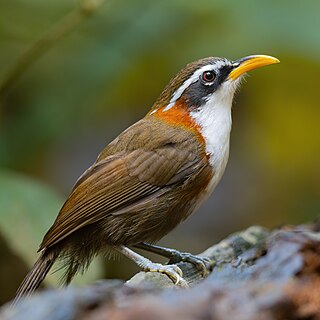
The green-billed coucal is a member of the cuckoos. It is endemic to Sri Lanka's wet zone and listed as Vulnerable on the IUCN Red List, as the small population declined due to forest destruction and fragmentation. It inhabits the tall rainforests of southwest Sri Lanka and nests in bushes. Its typical clutch is 2–3 eggs.

The red-faced malkoha is a member of the cuckoo order of birds, the Cuculiformes. This malkoha species is endemic to Sri Lanka

The Sri Lanka hanging parrot is a small parrot which is a resident endemic breeder in Sri Lanka.

The orange-billed babbler, also known as Ceylon rufous babbler or Sri Lankan rufous babbler, is a member of the family Leiothrichidae.

The yellow-billed babbler is a member of the family Leiothrichidae endemic to southern India and Sri Lanka. The yellow-billed babbler is a common resident breeding bird in Sri Lanka and southern India. Its habitat is scrub, cultivation and garden land. This species, like most babblers, is not migratory, and has short rounded wings and a weak flight and is usually seen calling and foraging in groups. It is often mistaken for the jungle babbler, whose range overlaps in parts of southern India, although it has a distinctive call and tends to be found in more vegetated habitats. Its name is also confused with Turdoides leucocephala, which is also known as white-headed babbler.

The ashy-headed laughingthrush is a member of the family Leiothrichidae. The laughingthrushes are a large family of Old World passerine birds characterised by soft fluffy plumage. These are birds of tropical areas, with the greatest variety in southeast Asia.

The scimitar babblers are birds in the genera Pomatorhinus and Jabouilleia of the large Old World babbler family of passerines. These are birds of tropical Asia, with the greatest number of species occurring in hills of the Himalayas.

The Indian scimitar babbler is an Old World babbler. It is found in peninsular India in a range of forest habitats. They are most often detected by their distinctive calls which include an antiphonal duet by a pair of birds. They are often hard to see as they forage through dense vegetation. The long curved yellow, scimitar-shaped bills give them their name. It has been treated in the past as subspecies of the white-browed scimitar babbler which is found along the Himalayas but now separated into two species, the peninsular Indian species and the Sri Lanka scimitar babbler.

The brown-capped babbler is a member of the family Pellorneidae.

The Sri Lanka hill myna, Ceylon myna or Sri Lanka myna is a myna, a member of the starling family. This bird is endemic to Sri Lanka.

The Sri Lanka spurfowl is a member of the pheasant family which is endemic to the dense rainforests of Sri Lanka. In Sri Lanka, this bird is known as haban kukula - හබන් කුකුලා in Sinhala.

The black-crowned scimitar babbler is a species of bird in the family Timaliidae.

The Javan scimitar babbler is a species of bird in the family Timaliidae. It is endemic to Java, Indonesia. The Sunda scimitar babbler, which is found in Sumatra, Borneo, and Malaysia, was formerly considered conspecific, with both species being grouped as the chestnut-backed scimitar babbler. Its natural habitats are subtropical or tropical moist lowland forest and subtropical or tropical moist montane forest.

The Red-billed Scimitar-Babbler is a species of bird in the family Timaliidae. It is found in Northeast India, Southeast Asia and adjacent parts of southern China. It has a long reddish-orange decurved bill that is typical of Scimitar-Babblers, a rather long white supercilium, and brown upperparts and tail. Sexes are similar.

The streak-breasted scimitar babbler is a species of bird in the family Timaliidae.

The white-browed scimitar babbler is a species of bird in the family Timaliidae. It is found in Bangladesh, Bhutan, Cambodia, India, Laos, Myanmar, Nepal, Thailand, and Vietnam. Its natural habitats are subtropical or tropical moist lowland forest and subtropical or tropical moist montane forest.

The slender-billed scimitar babbler is a passerine bird in the Old World babbler family. It is found from the Himalayas to north-western Vietnam. Its natural habitat is subtropical or tropical moist montane forests.

The Taiwan scimitar babbler is a bird in the family Timaliidae, the Old World babblers. It is endemic to Taiwan. The species was first described by Robert Swinhoe in 1859. It was formerly treated as a subspecies of the streak-breasted scimitar babbler. Its population is declining, but not rapidly enough for it to be considered vulnerable.




















